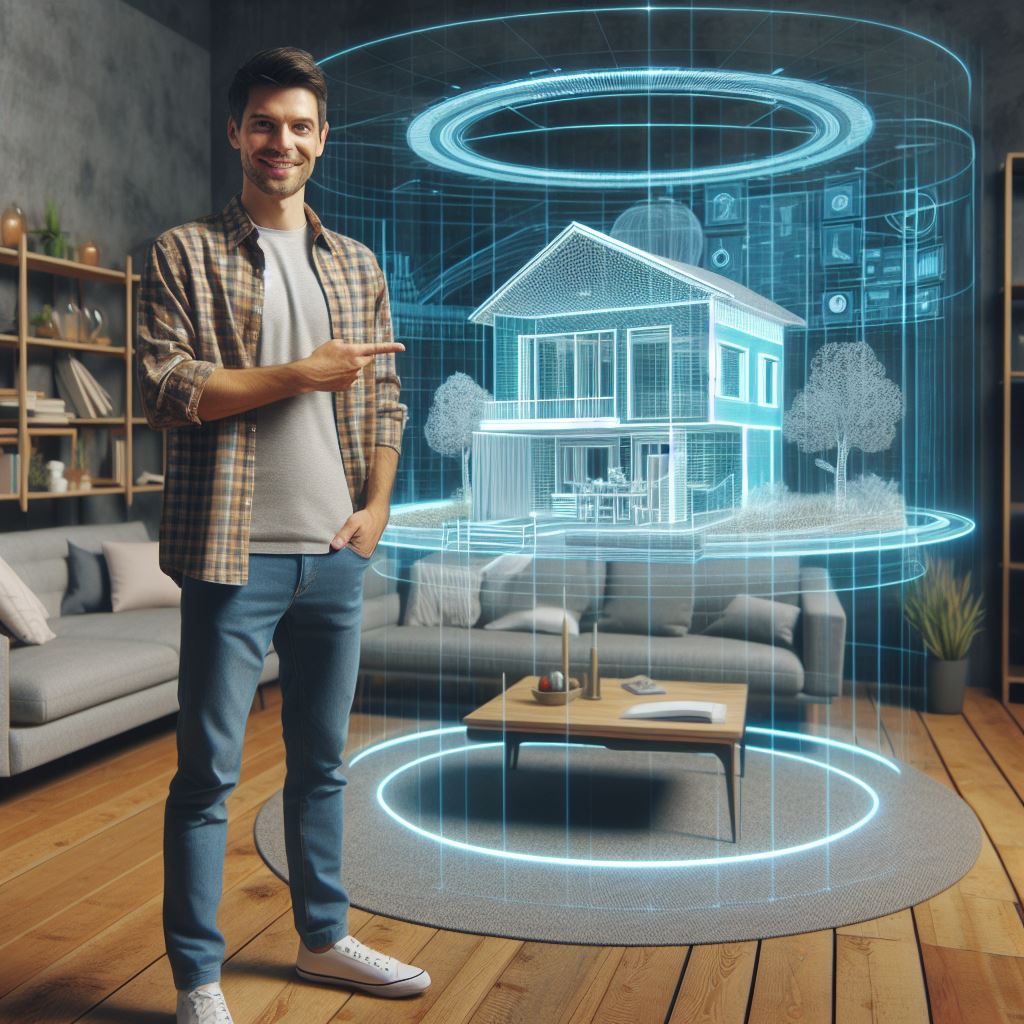Introduction
Virtual tours have become a game-changer in the real estate industry, revolutionizing the way homes are being sold.
Offering a realistic and immersive experience, virtual tours allow potential buyers to explore properties from the comfort of their own homes.
Virtual tours are interactive, 3D simulations that provide a lifelike representation of a property.
Using specialized software and high-quality imagery, these tours allow users to navigate through a home, viewing each room and examining details from different angles.
Virtual tours have become a crucial tool for real estate agents and sellers to attract potential buyers.
By providing a more engaging and interactive experience, virtual tours bridge the gap between physical viewing and online searching.
They offer a convenient way for buyers to explore multiple properties without the need for in-person visits.
In this blog post, we will explore the benefits and effectiveness of virtual tours in selling homes.
We will discuss how virtual tours enhance the buyer’s experience and increase engagement.
So let’s dive in and explore the exciting world of virtual tours!
Benefits of Virtual Tours for Home Sellers
In the fast-paced world of real estate, staying ahead of the curve is crucial for sellers looking to showcase their properties effectively.
Virtual tours have emerged as a game-changer, revolutionizing the way homes are marketed and viewed.
In this section, we’ll delve into the benefits of virtual tours for home sellers, exploring how this cutting-edge technology enhances the selling process.
Enhanced Visual Experience
Gone are the days of static images and flat floor plans.
Virtual tours provide potential buyers with an immersive and interactive experience, allowing them to navigate through a property as if they were physically present.
This three-dimensional exploration enables prospective buyers to get a real sense of the space, helping them envision themselves living in the home.
The attention to detail in virtual tours captures the essence of a property far better than traditional marketing methods.
Increased Interest and Engagement
Virtual tours captivate the audience’s attention from the moment they click on a listing.
The dynamic nature of the experience fosters a deeper connection with the property, increasing the likelihood of a potential buyer exploring the entire space.
This heightened engagement translates to more qualified leads and a greater chance of converting interest into offers.
Broader Reach and Accessibility
Virtual tours break down geographical barriers, enabling potential buyers to explore properties from anywhere in the world.
This accessibility is especially beneficial in the current global landscape, where travel restrictions may limit physical visits.
Sellers can attract a broader audience, including international buyers, thereby expanding their market reach and increasing the chances of a quicker sale.
Cost-Effective Marketing Tool
Compared to traditional marketing methods, virtual tours offer a cost-effective solution for sellers.
The initial investment in creating a virtual tour pays off in reduced expenses associated with open houses, printed materials, and travel.
The virtual tour serves as a comprehensive and reusable marketing tool, available 24/7 to potential buyers, minimizing the need for additional promotional efforts.
In fact, virtual tours have become an indispensable tool in the arsenal of home sellers.
The enhanced visual experience, increased interest and engagement, broader reach, and cost-effectiveness make virtual tours a strategic choice for those looking to stand out in the competitive real estate market.
Embracing this technology is not just a trend; it’s a smart investment in the future of home sales.
Read: AI in Real Estate: A Game Changer
Types of Virtual Tours
In the fast-paced world of real estate, staying ahead of the competition is crucial.
One innovative tool that has taken the industry by storm is the use of virtual tours to showcase homes in 3D.
This game-changing technology offers potential buyers an immersive and interactive experience, providing a virtual walkthrough of properties from the comfort of their own homes.
Let’s delve into the different types of virtual tours that are reshaping the way homes are bought and sold.
360-Degree Virtual Tours
Imagine being able to step inside a home and explore every nook and cranny without physically being there.
That’s exactly what 360-degree virtual tours offer.
Using specialized cameras, real estate professionals can capture a property from every angle, allowing potential buyers to virtually stroll through rooms, hallways, and outdoor spaces.
This type of tour provides a comprehensive view, giving a true sense of the property’s layout and design.
Interactive Floor Plans
Interactive floor plans take virtual tours to the next level by providing a bird’s-eye view of the property.
Users can navigate through different rooms and spaces by clicking on specific areas of the floor plan.
This feature enhances the overall user experience, offering a more intuitive and engaging way to explore the property’s layout.
Virtual Reality (VR) Tours
For those seeking an even more immersive experience, virtual reality tours are the answer.
By using VR headsets, potential buyers can virtually step into a home and experience it in three dimensions.
This technology brings a new level of realism, making it feel as though the viewer is physically present in the property.
VR tours are revolutionizing the buying process, especially for international or remote buyers who may not have the opportunity to visit in person.
Aerial and Drone Tours
To capture the full scope of a property, aerial and drone tours are becoming increasingly popular.
Drones equipped with high-quality cameras can capture stunning aerial views of the property and its surroundings.
This type of tour is particularly effective for showcasing expansive estates, waterfront properties, or homes with unique landscapes.
In essence, the world of virtual tours offers a diverse range of options for showcasing homes in 3D.
From 360-degree perspectives to virtual reality experiences, these technologies are transforming the real estate industry, providing buyers with an unprecedented level of access and engagement.
As the demand for virtual tours continues to rise, real estate professionals who embrace these innovative tools will undoubtedly stand out in a competitive market.
Read: Boost Sales: CRM Tools for Real Estate Agents

Creating Engaging Virtual Tours
Virtual tours have become an essential tool for selling homes in today’s digital age.
With the advancements in technology, potential buyers can now virtually explore properties without leaving the comfort of their own homes.
As a real estate agent or homeowner looking to sell a property, it is crucial to create engaging virtual tours that capture the attention of prospective buyers. Here are some tips on how to do just that:
Hiring a professional photographer or videographer
To ensure the highest quality virtual tour, it is essential to hire a professional photographer or videographer who specializes in real estate.
Their expertise and equipment will enable them to capture stunning visuals that highlight the property’s best features.
Professional-grade photos and videos will significantly enhance the overall virtual tour experience for potential buyers.
Staging the home for virtual tours
Just as staging a home is important for in-person showings, it is equally important for virtual tours.
Stage the home appropriately by decluttering, organizing, and arranging furniture in an appealing and inviting manner.
This will help potential buyers visualize themselves living in the space and create a more engaging virtual tour.
Utilizing the right technology and equipment
Investing in the right technology and equipment is crucial for creating engaging virtual tours.
Consider using a virtual tour software that allows for easy navigation and interactive features.
Additionally, ensure that you have the necessary equipment, such as a high-quality camera and tripod, to capture clear and stable visuals.
Incorporating high-quality visuals and interactive features
To make your virtual tour stand out, incorporate high-quality visuals and interactive features.
This can include adding descriptive text, floor plans, and even 360-degree views of different areas within the property.
These features will provide potential buyers with a comprehensive and immersive virtual tour experience.
By following these tips and creating engaging virtual tours, you can effectively showcase the unique features and selling points of a property.
Additionally, virtual tours can save time and effort for both sellers and buyers by narrowing down the list of potential properties to visit in person.
Embrace the power of technology and provide an engaging virtual tour experience to attract more potential buyers.
Read: Ethical Marketing in Real Estate
Virtual Tours vs. Traditional Property Listings
In the ever-evolving landscape of real estate, virtual tours have emerged as a game-changer, revolutionizing the way homes are bought and sold.
Let’s delve into the fascinating realm of Virtual Tours vs. Traditional Property Listings and explore why the former has become the new standard.
Advantages of Virtual Tours over Static Images
Traditional property listings often rely on static images to showcase a home’s features.
Virtual tours, on the other hand, provide a dynamic, immersive experience.
The ability to virtually navigate through a property offers potential buyers a comprehensive understanding of the space, transcending the limitations of static imagery.
It’s like bringing the property to life, allowing buyers to explore every nook and cranny.
Personal Touch and Visualization of the Space
Virtual tours inject a personal touch into the home-buying process.
Instead of just seeing pictures, prospective buyers can virtually step into each room, getting a feel for the flow and ambiance of the space.
This added dimension fosters a deeper connection with the property, enabling buyers to envision themselves living there.
The emotional resonance created through this immersive experience often translates into a more informed and confident purchasing decision.
Opportunity for Potential Buyers to Explore at Their Own Pace
One significant advantage of virtual tours is the freedom they afford potential buyers to explore properties at their own pace.
Whether it’s a quick walkthrough or a meticulous examination of every detail, virtual tours cater to diverse preferences.
This flexibility not only enhances the buyer’s experience but also ensures that they don’t miss essential features that might go unnoticed in traditional listings.
Saving Time for Both Buyers and Sellers
Time is of the essence in real estate. Virtual tours streamline the home-buying process, saving time for both buyers and sellers.
Prospective buyers can virtually tour multiple properties without leaving their homes, narrowing down their options efficiently.
For sellers, this means attracting serious buyers who have already vetted the property virtually, reducing unnecessary foot traffic and expediting the sales cycle.
In a nutshell, virtual tours have transcended the traditional confines of property listings.
Their dynamic, immersive nature not only provides a more engaging experience but also saves time for all parties involved.
As technology continues to evolve, virtual tours are poised to be the cornerstone of the modern real estate industry.
Read: Disclosure Laws in Property Sales
Virtual Tours and the Home Buying Process
In the ever-evolving landscape of real estate, virtual tours have emerged as a game-changer, revolutionizing the way homes are bought and sold.
As we delve into the digital era, the integration of 3D technology into the home buying process is reshaping the industry, offering unparalleled advantages for both sellers and buyers alike.
Imagine being able to explore a potential home from the comfort of your couch, immersing yourself in its every nook and cranny.
Virtual tours provide prospective buyers with an immersive experience, allowing them to virtually walk through a property as if they were there in person.
This technology transcends the limitations of static images, offering a lifelike representation that fosters a deeper connection between the buyer and the property.
Reducing Unnecessary Property Visits
Gone are the days of exhaustive property visits.
Virtual tours significantly reduce the need for in-person showings, saving both time and effort for buyers and sellers.
By offering a comprehensive view of the property online, potential buyers can filter through options more efficiently, narrowing down their choices before committing to a physical visit.
This not only streamlines the process but also ensures that each property visit is more purposeful and aligned with the buyer’s preferences.
Saving Travel Expenses for Out-of-Town Buyers
For out-of-town buyers, the prospect of traveling long distances to view properties can be daunting.
Virtual tours eliminate this hurdle by providing a realistic and detailed walkthrough of homes, negating the need for costly and time-consuming journeys.
This not only makes the home-buying process more accessible for distant buyers but also opens up the market for sellers to attract a broader audience.
Facilitating Remote Decision-Making for Buyers
In an era where remote work and global mobility are on the rise, virtual tours facilitate remote decision-making.
Buyers can collaborate with agents and make informed choices without physically being present, making the process more adaptable to today’s dynamic lifestyles.
This not only expedites the decision-making process but also accommodates the needs of buyers who may be constrained by time or location.
Increasing Buyer Confidence and Trust in the Property
The immersive nature of virtual tours instills confidence in buyers, allowing them to explore a property thoroughly before making a commitment.
By providing a transparent and detailed view of the home, virtual tours build trust between the buyer and the seller.
This transparency is a powerful tool in today’s competitive real estate market, enhancing the overall buying experience.
In a nutshell, virtual tours are reshaping the home buying process, offering benefits that extend far beyond mere convenience.
From reducing unnecessary visits to fostering remote decision-making, these 3D experiences are transforming the real estate landscape.
As technology continues to advance, the integration of virtual tours will undoubtedly become a cornerstone in the home buying journey, providing an unparalleled avenue for buyers and sellers to connect in the digital age.
Challenges and Limitations of Virtual Tours
In the dynamic landscape of real estate, virtual tours have emerged as a groundbreaking tool, revolutionizing the way homes are showcased and sold.
Real estate agents and buyers must consider challenges and limitations with virtual tours, inherent in any technology.
Technical Issues and Compatibility Concerns
One of the primary challenges faced in the realm of virtual tours is the prevalence of technical issues and compatibility concerns.
The seamless experience promised by these tours heavily relies on stable internet connections and up-to-date devices.
Slow internet speeds or outdated hardware can lead to frustrating glitches, hindering the immersive experience and potentially driving away interested buyers.
Inability to Fully Replicate the Physical Experience
While virtual tours provide a comprehensive view of a property, they fall short in replicating the true physical experience of being inside a home.
The hardwood floors feel beneath, freshly painted walls scent the air, and neighborhood sounds shape decision-making significantly.
Virtual tours, despite their advancements, cannot fully capture these subtleties.
Perception of Distorted or Misleading Visuals
Another challenge lies in the perception of distorted or misleading visuals.
The wide-angle lenses used in virtual tour cameras can sometimes create an illusion of spaciousness that may not align with reality.
This can lead to disappointment and dissatisfaction when potential buyers physically visit the property, expecting a different spatial arrangement than what they perceived through the virtual tour.
Limited Access for Individuals Without Internet or Modern Devices
The digital divide presents a significant limitation for individuals without reliable internet access or modern devices.
This demographic, often overlooked in the virtual realm, may face challenges accessing virtual tours altogether.
As a result, real estate agents must balance their marketing strategies to cater to a diverse audience, ensuring inclusivity for all potential buyers.
All in all, while virtual tours have undoubtedly transformed the home-buying experience, acknowledging and addressing these challenges is crucial for a well-rounded approach.
Innovation is crucial in overcoming virtual tour limitations, unlocking real estate potential amidst evolving technology.
Conclusion
Virtual tours provide numerous benefits for selling homes.
They enable potential buyers to have an immersive experience and get a realistic feel of the property.
These virtual tours also save time and effort for both real estate professionals and buyers.
The convenience of virtual tours allows buyers to explore multiple properties without physically visiting each one.
This not only expands their options but also saves them from the hassle of scheduling and traveling.
Additionally, virtual tours can reach a wider audience as they can be easily shared on various online platforms.
For real estate professionals, adapting to virtual tour technology is crucial in staying competitive.
It allows them to showcase properties more effectively and attract more potential buyers.
Agents can differentiate themselves by incorporating virtual tours, offering clients a unique selling point in their marketing strategies.
The future of virtual tours in the real estate industry seems promising.
Advancing technology makes virtual and augmented reality more accessible, further enhancing the virtual tour experience.




